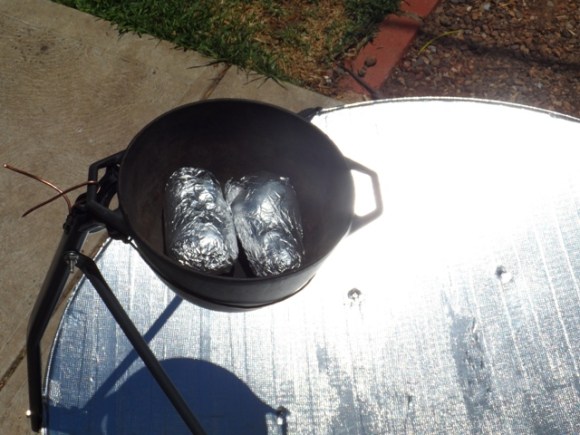
Hone your survival skills by harnessing the sun’s rays to cook your meals. [Robert] and his daughter turned an old satellite dish into a solar cooker. The image above shows them baking some potatoes, but the temperatures inside the cast iron vessel are high enough to let you cook most foods.
The dish was originally used for satellite television but has been collecting dust in the shed for quite some time. When [Robert] came across a roll of foil tape in his workshop he decided to give the project a whirl. His daughter helped out by peeling away the tape backing (this can be much harder than it sounds) while he applied the reflective material trying to keep it free of wrinkles. After a close call [Robert] donned a pair of welding goggles when positioning the dish. If the light intensity can get the pot up as high as 428 degree Fahrenheit we’re sure it can cause flash blindness.
Unlike other dish cookers we’ve seen, [Robert] didn’t use the original mount for holding the dish in place. He just set it on three bricks and directed it by hand. To keep the intensity focused on the kettle he had to reposition it every 15 minutes.
We wonder if the heat is too much for building a sun tracking solar power harvester?














I did this as a project in middle school… takes a long time, even with the proper parabolic positioning…. and you have to keep repositioning it. I would imagine we could fix that with an Arduino…
An entire Arduino for this would be a huge waste of silicon. A single 8 pin mcu, some pwm code, four photoresistors and a 2 axis motor driver will do. The analog version would use 2 opamps instead of the mcu but would be a lot less efficient by driving motors the linear way.
Sorry for reporting the above post, obviously a mistake. That report link is definitely both the wrong place and color.
Come on, a $5 single chip is a waste of silicon?
http://www.adafruit.com/products/123
What — You think they just find silicon on the beach or something?
The OP mentioned a full Arduino, not a single chip.
And BTW, a 8 pin mcu can cost less than $1.
Wouldn’t carpet spray adhesive and kitchen foil work out easier and more efficient?
http://fredhack.blogspot.com/2012/09/satellite-dish-solar-cooker.html
Like we did? Took us a grand total of 10 minutes to make one afternoon after a hack-a-thon day.
Kitchen foil is not very reflective compared to mylar or reflective tape you can get at an auto parts store. You would get about 1/2 the heat
Proving once again….
The family that makes together bakes together.
Seems to be working much better with an old tv screen:
It even melts pennies!
“Burning Stuff With 2000ºF Solar Power!! ”
http://www.youtube.com/watch?v=jrje73EyKag
That video made me cringe too many times. Little kids playing around and looking at the hot spot, people sticking their hands right where they shouldn’t, and not a single piece of eye protection.
Other than that, it’s a pretty effective device. Now if only there were huge junk TVs like that laying around my neighborhood.
Agreed, on all counts.
Cool video. I know what to do with the 50″ TV my friend is tossing my way. Too expensive to fix (his excuse to get a new one), so I can get the lens and DLP chip among other parts. Will try ants first :P
OMG he dumped gas directly from the can! That’s sooooooooooooooooo dangerous!
Very clever hack with a dish. One thing most solar collectors have is a cover to retain the heat. Putting the dish inside a box with a transparent lid can help cook the food faster.
It looks like a dutch oven is used for the baking, they usually have a heavy lid. Maybe it was left off to show the contents.
Inre: baking/cooking temps, we use 400 degrees F to bake our potatoes, that is higher than most of the items we bake. An equatorial mount would be a good thing for tracking the sun.